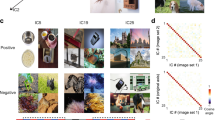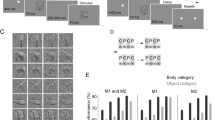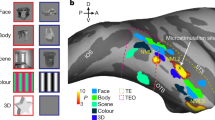Abstract
The way that we perceive and interact with objects depends on our previous experience with them. For example, a bird expert is more likely to recognize a bird as a sparrow, a sandpiper or a cockatiel than a non-expert1. Neurons in the inferior temporal cortex have been shown to be important in the representation of visual objects; however, it is unknown which object features are represented and how these representations are affected by categorization training. Here we show that feature selectivity in the macaque inferior temporal cortex is shaped by categorization of objects on the basis of their visual features. Specifically, we recorded from single neurons while monkeys performed a categorization task with two sets of parametric stimuli. Each stimulus set consisted of four varying features, but only two of the four were important for the categorization task (diagnostic features). We found enhanced neuronal representation of the diagnostic features relative to the non-diagnostic ones. These findings demonstrate that stimulus features important for categorization are instantiated in the activity of single units (neurons) in the primate inferior temporal cortex.
This is a preview of subscription content, access via your institution
Access options
Subscribe to this journal
Receive 51 print issues and online access
$199.00 per year
only $3.90 per issue
Buy this article
- Purchase on Springer Link
- Instant access to full article PDF
Prices may be subject to local taxes which are calculated during checkout




Similar content being viewed by others
References
Tanaka, J. W. & Taylor, M. Object categories and expertise: is the basic level in the eye of the beholder? Cogn. Psychol. 23, 457–482 (1991).
Bruner, J. S. On perceptual readiness. Psychol. Rev. 64, 123–152 (1957).
Sands, S. F., Lincoln, C. E. & Wright, A. A. Pictorial similarity judgments and the organization of visual memory in the rhesus monkey. J. Exp. Psychol. Gen. 111, 369–389 (1982).
Sugihara, T., Edelman, S. & Tanaka, K. Representation of objective similarity among three-dimensional shapes in the monkey. Biol. Cybern. 78, 1–7 (1998).
Vogels, R. Categorization of complex visual images by rhesus monkeys. Part 1: behavioural study. Eur. J. Neurosci. 11, 1223–1238 (1999).
Vogels, R. Categorization of complex visual images by rhesus monkeys. Part 2: single-cell study. Eur. J. Neurosci. 11, 1239–1255 (1999).
Delorme, A., Richard, G. & Fabre-Thorpe, M. Ultra-rapid categorisation of natural scenes does not rely on colour cues: a study in monkeys and humans. Vision Res. 40, 2187–2200 (2000).
Freedman, D. J., Riesenhuber, M., Poggio, T. & Miller, E. K. Categorical representation of visual stimuli in the primate prefrontal cortex. Science 291, 312–316 (2001).
Logothetis, N. K., Pauls, J. & Poggio, T. Shape representation in the inferior temporal cortex of monkeys. Curr. Biol. 5, 552–563 (1995).
Sigala, N., Gabbiani, F. & Logothetis, N. K. Visual categorization and object representation in monkeys and humans. J. Cogn. Neurosci. 14. 1–12 (2001).
Gross, C. G., Roche-Miranda, C. E. & Bender, D. B. Visual properties of neurons in the inferotemporal cortex of the monkey. J. Neurophysiol. 35, 96–111 (1972).
Tanaka, K. Inferotemporal cortex and object vision. Annu. Rev. Neurosci. 19, 109–139 (1996).
Gauthier, I., Anderson, A. W., Tarr, M. J., Skudlarski, P. & Gore, J. C. Levels of categorization in visual recognition studied using functional magnetic resonance imaging. Curr. Biol. 7, 645–651 (1997).
Gauthier, I., Skudlarski, P., Gore, J. C. & Anderson, A. W. Expertise for cars and birds recruits brain areas involved in face recognition. Nature Neurosci. 3, 191–197 (2000).
Nosofsky, R. M. Attention, similarity, and the identification–categorization relationship. J. Exp. Psychol. Gen. 115, 39–57 (1986).
Schiller, P. H. & Koerner, F. Discharge characteristics of single units in superior colliculus of the alert rhesus monkey. J. Neurophysiol. 34, 920–936 (1971).
Sheinberg, D. L. & Logothetis, N. K. The role of temporal cortical areas in perceptual organization. Proc. Natl Acad. Sci. USA 94, 3408–3413 (1997).
Sheinberg, D. L. & Logothetis, N. K. Noticing familiar objects in real world scenes: the role of temporal cortical neurons in natural vision. J. Neurosci. 21, 1340–1350 (2001).
Schyns, P. Diagnostic recognition: task constraints, object information, and their interactions. Cognition 67, 147–179 (1998).
Judge, S., Richmond, B. & Chu, F. Implantation of magnetic search coils for measurement of eye position: An improved method.. Vision Res. 20, 535–538 (1980).
Acknowledgements
We thank Z. Kourtzi, M. Silver, S. Smirnakis and A. Tolias for comments on the manuscript and discussions. We also thank J. Pauls and D. Sheinberg for help and advice at various stages of the project. This work was supported by the Max Planck Society.
Author information
Authors and Affiliations
Corresponding author
Ethics declarations
Competing interests
The authors declare no competing financial interests.
Rights and permissions
About this article
Cite this article
Sigala, N., Logothetis, N. Visual categorization shapes feature selectivity in the primate temporal cortex. Nature 415, 318–320 (2002). https://doi.org/10.1038/415318a
Received:
Accepted:
Issue Date:
DOI: https://doi.org/10.1038/415318a
This article is cited by
-
Mouse visual cortex areas represent perceptual and semantic features of learned visual categories
Nature Neuroscience (2021)
-
Task-specific modulation of PFC activity for matching-rule governed decision-making
Brain Structure and Function (2021)
-
Attractor-state itinerancy in neural circuits with synaptic depression
The Journal of Mathematical Neuroscience (2020)
-
Emergence of abstract rules in the primate brain
Nature Reviews Neuroscience (2020)
-
Visual and Category Representations Shaped by the Interaction Between Inferior Temporal and Prefrontal Cortices
Cognitive Computation (2018)
Comments
By submitting a comment you agree to abide by our Terms and Community Guidelines. If you find something abusive or that does not comply with our terms or guidelines please flag it as inappropriate.



